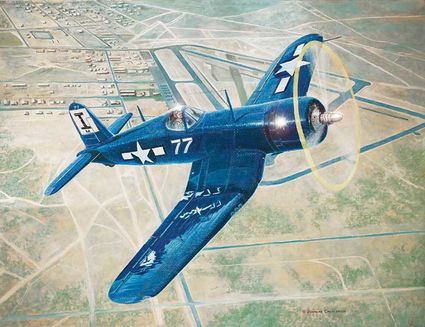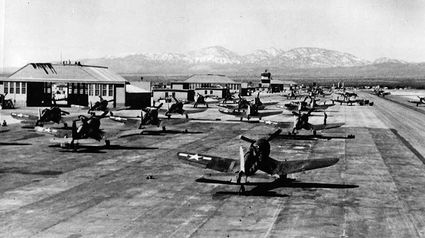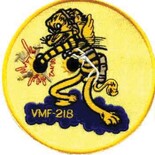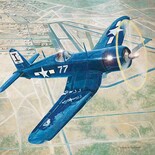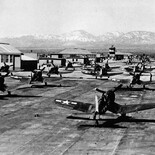Memories of Marine Corps Auxiliary Air Station Mojave
Short Flights
I have been thinking a lot about the Marines and the aircraft they flew, when they served here during World War II. I sense their presence every time I walk into the Administration Building or Building One at Mojave Air and Space Port.
At least thirty-two United States Marine Corps squadrons are believed to have trained at Marine Corps Auxiliary Air Station (MCAAS) Mojave, and a number of squadrons were actually formed here, including Marine Fighting Squadron 225 (VMF-225) commissioned January 1, 1943 flying the Vought F4U-1 Corsair. VMF-225 participated in many combat operations in the New Hebrides Islands from August 1944 until January 1945.
They returned to the United States in February 1945 and were eventually stationed at MCAS Cherry Point, North Carolina. They had interim basing at MCAAS Mojave, Calif .; MCAS Santa Ana, Calif. and MCAS Edenton, North Carolina.
Another USMC Squadron organized at MCAAS Mojave on July 1, 1943 was VMF-214, known as the 'Hellions.' They were officially commissioned on September 15, 1943.
They departed the U.S. in December 1943 on board the USS Barnes (CVE-20) and arrived at Espiritu Santo on January 5, 1944. They flew throughout the South Pacific, but saw the majority of their fighting during the Philippines Campaign (1944-1945). The squadron was credited with downing eighteen enemy aircraft during the course of the war. Their first combat action took place on February 15, 1944 when they covered the allied landing on Green Island.
On April 27 the squadron moved to Green Island where they remained until November. During their time on Green Island their squadron was one of several Marine squadrons that let a civilian contractor, Charles Lindbergh, fly strikes against the Japanese garrison at Rabaul.
Most people are unaware that Charles A. Lindbergh landed at Marine Corps Auxiliary Air Station (MCAAS) Mojave at 12:40 p.m., April 15, 1944.
On page 779 of the "The Wartime Journals of Charles A. Lindbergh" it states that he flew from Palm Springs, after a meeting with Russell Vought, to Mojave.
He had flown to Mojave to have a conference with Marine officers regarding their Corsair operations and he was flying a F4U Corsair that had been assigned to him. At the time, Lindbergh was a consultant for the Vought Aircraft Division of United Aircraft Corporation. He had developed throttle settings and engine leaning techniques that significantly increased the range of the aircraft.

It was during that period that he visited Mojave and later in the month of April, he was in the Pacific Theater of Operations as a Corsair technical representative. He left North Island in a Navy R4D at 9:38 p.m. on April 24, and arrived at Kaneohe Naval Air Station on Oahu, Hawaii fifteen hours, seven minutes after take-off.
According to a website dedicated to the history of the 307th Bomb Group "On May 22, 1944, Lindbergh flew his first combat mission, escorting Grumman TBF's (torpedo bombers) to Rabaul with a Marine Corsair squadron and strafing assigned ground targets before starting home. Before returning to Guadalcanal on June 10 he had flown 13 missions to Northern Solomon and Rabaul targets from Green and Emirau Islands."
VMF-451 was formed at Mojave and here is a youtube link interviewing some of the pilots who flew with the squadron. http://www.youtube.com/watch?v=FBvYfNi51wE "Expecting island duty, the men of Marine Squadron VMF 451 were surprised to discover they would be flying off an aircraft carrier in the Pacific. In January, 1945, the Blue Devils, boarded USS Bunker Hill (CV-17) in San Francisco and headed into battle. During their short four-and-a-half month tour of duty, they flew combat missions over Tokyo, Okinawa and Iwo Jima."
"Blue Devils traces the lives of the Blue Devils from the time they began training in the States until they returned home from combat in May, 1945. Told by pilots themselves, this film shares the amazing and miraculous stories of their fight for freedom."
Aviation artist Douglas Castleman was commissioned to paint a Corsair flying over MCAAS Mojave for the Mojave Transportation Museum Foundation to honor all of the Marines who served here. He chose a Corsair from VMF-511 with a background of MCAAS Mojave depicted in 1944. VMF-511 moved to MCAAS on September 10, 1944, and began carrier qualification training. This beautiful painting hangs in the Corsair Room in Building One (the original base headquarters).
See you on our next flight!


